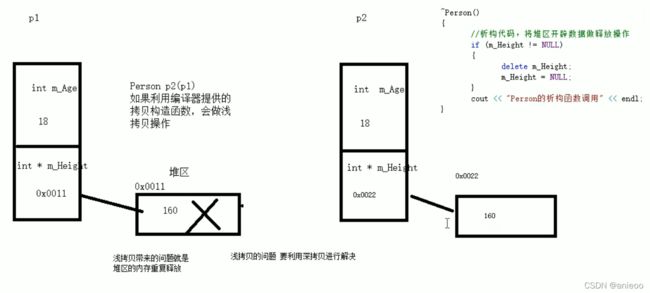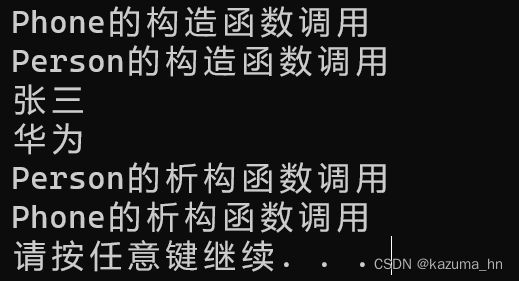C++ | 期末冲刺版①
目录
new 的使用
占位参数
做函数的返回值注意:不要返回局部变量引用
类和对象
封装
将一个类拆分成两个文件
point.h(写类的框架,写函数声明)
point.cpp
构造和析构
拷贝构造函数
有参和无参
深拷贝与浅拷贝
初识化列表
静态成员
new 的使用
int *p=new int(10);
int *array=new int[10];
delete p;
delete[ ] array;
占位参数
注意事项:如果某个位置已经有了默认参数,那么从这个位置往后都要有默认参数
//从b开始往后一的参数都有默认参数
int fun2(int a,int b= 10;int c =20)
{
}
如果函数的声明有默认参数,函数的实现就不能有默认参数了。
声明和实现只能有一个有默认参数。
做函数的返回值
注意:不要返回局部变量引用
用法:函数调用作为左值
#include
using namespace std;
int& test1()
{
int a = 10;//栈区
return a;
}
int& test2()
{
static int b = 20;//静态变量存放在全局区,全局区的数据在程序结束后系统释放
return b;
}
int main(void)
{
int& ret = test1();
int& ret2 = test2();
cout << ret2 << endl;
//作为左值
test2() = 1000;//如果函数的返回值是引用,这个函数调用可以作为左值
cout << ret2 << endl;
cout << ret << endl;//第一次结果正确是因为编译器做了保留
cout << ret;//第二次结果错误是因为a的内存已经释放
return 0;
}
类和对象
class
{
};//后面有个分号,忘记了你就完蛋了!
封装
//成员函数判断是否相等(一个参数)
bool issamebyClass(Cube &c)
{
if (C_H== c.geth() && C_L == c.getl() && C_W == c.getw())
{
return true;
}
return false;
}
//全局函数(两个参数)
bool issame(Cube &c1, Cube &c2)
{
if (c1.geth() == c2.geth() && c1.getl() == c2.getl() && c1.getw() == c2.getw())
{
return true;
}
return false;
}
将一个类拆分成两个文件
point.h(写类的框架,写函数声明)
#pragma once
#include
using namespace std;
class Point
{
public:
void setx(int x);
int getx();
void sety(int y);
int gety();
private:
int c_x;
int c_y;
};
point.cpp
#include"point.h"
//Point::告诉编译器这是Point作用域下面的一个成员函数
void Point::setx(int x)
{
c_x = x;
}
int Point::getx()
{
return c_x;
}
void Point::sety(int y)
{
Point::c_y = y;
}
int Point::gety()
{
return c_y;
}构造和析构
Person p;//默认构造函数调用
/*注意:使用默认构造函数的时候,不要加(),编译器会认为这是一个函数的声明
例如:Person p1();不会认为在创建对象*/
Person p2(10);//有参构造函数调用
Person p3(p2);//拷贝构造函数调用
cout << "p2的年龄为" << p2.age << endl;
cout << "p3的年龄为" << p3.age << endl;
拷贝构造函数
Person(const Person& p)
{
cout << "Person的拷贝构造函数调用" << endl;
m_Age = p.m_Age;
}有参和无参
总结:
用户提供了有参,编译器不会提供无参,但会提供拷贝;
用户提供了拷贝,编译器什么构造函数都不会提供。
深拷贝与浅拷贝
深浅拷贝是面试的一个经典的问题,也是常见的一个坑。
浅拷贝:简单的赋值拷贝操作。
深拷贝:在堆区中重新申请空间,进行拷贝操作。
浅拷贝带来的问题——内存重复释放。
#include
using namespace std;
//深拷贝与浅拷贝问题
class Person
{
public:
Person()
{
cout << "Person的默认构造函数调用" << endl;
}
Person(int age,int height)
{
m_Height = new int(height);
m_Age = age;
cout << "Person的有参构造函数调用" << endl;
}
Person(const Person& p)
{
cout << "Person的拷贝构造函数调用" << endl;
m_Age = p.m_Age;
m_Height = p.m_Height;编译器默认实现的就是这行代码
}
~Person()
{
//将堆区开辟的数据进行释放
if (m_Height !=NULL)
{
delete m_Height;
m_Height = NULL;
}
cout << "Person的析构构造函数调用" << endl;
}
int m_Age;
int* m_Height;//为什么要用指针——要把身高开辟到堆区
};
void test()
{
Person p1(18,166);
cout << p1.m_Age<<"\t" << *p1.m_Height << endl;
Person p2(p1);
cout << p2.m_Age<<"\t" <<*p2.m_Height<< endl;
}
int main(void)
{
test();
system("pause");
return 0;
}
浅拷贝的这个问题需要用深拷贝来解决
重新在堆区找一块内存来存放他。
自己实现拷贝构造函数来解决浅拷贝带来的问题
解决:
深拷贝——手动创建拷贝构造函数。
Person(const Person& p)
{
cout << "Person的拷贝构造函数调用" << endl;
m_Age = p.m_Age;
//m_Height = p.m_Height;编译器默认实现的就是这行代码
//深拷贝操作
m_Height = new int(*p.m_Height);
}初识化列表
作用:
C++提供了初始化列表语法,用来初始化对象。
语法:
构造函数():属性1(值1),属性2(值2)…{}
Person():age(1),height(160){}//没有分号
类对象作为类成员
当其他类的对象作为本类的成员时,构造时先构造其他类的对象,再构造自身。
析构呢?与构造函数相反。
自身的析构函数先进行,之后其它类再进行。
class Person{
Phone a;
};
静态成员
静态成员就是在成员变量和成员函数前面加上关键字啊static,称为静态成员。
静态成员分为:
- 静态成员变量
- 所有对象共享同一份数据
- 在编译阶段分配内存
- 类内声明,类外初始化
- 静态成员函数
- 所有成员共享同一个函数
- 静态成员函数只能访问静态成员变量
-
#includeusing namespace std; class Person { public: //静态成员函数 static void func() { age = 100;//静态的成员函数可以访问静态的成员变量,不可以访问非静态的成员变量 //无法区分到底是哪个对象的成员变量 cout << "static void func调用" << endl; } static int age; //静态成员函数也是有访问权限的 private: static void func() { } }; void test01() { //两种访问方式 //通过对象访问 Person p; p.func(); //通过类名也可以访问 Person::func(); //Person::func2();类外访问不到私有的静态成员函数 } int main(void) { test01(); system("pause"); return 0; }



